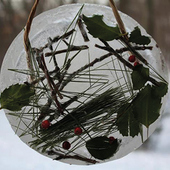
1: Puddle jumping
Find icy puddles and jump in them. Few winter activities are more simple or joyful than smashing the thin sheet of ice over a shallow puddle.
Draw around the puddles with chalk – go back later to see if they’ve shrunk or expanded. Why? Remember that water expands when it freezes.
Count the puddles. Which puddle is the biggest and which is the smallest? With older children, use a metre rule to measure the dimensions of the puddle. Can you find a puddle that is longer than a child is tall?
2: Make ice pendants
 A magical activity for a truly freezing night! Pour water into shallow vessels such as plastic food boxes, egg poachers, saucers, ice-cube trays and sweet-tin lids. Collect lots of natural materials – leaves, tiny cones, pebbles, flower petals, feathers, shells and so on. Place one or two in each vessel of water – or arrange to make an attractive picture in one of the larger lids. Loop a short length of string and place the ends into the water. Leave outdoors to freeze overnight – the string will freeze into the water so that your beautiful pendant can be hung from a tree the next morning. Add sparkle or colour with glitter, liquid paint or food colouring.
A magical activity for a truly freezing night! Pour water into shallow vessels such as plastic food boxes, egg poachers, saucers, ice-cube trays and sweet-tin lids. Collect lots of natural materials – leaves, tiny cones, pebbles, flower petals, feathers, shells and so on. Place one or two in each vessel of water – or arrange to make an attractive picture in one of the larger lids. Loop a short length of string and place the ends into the water. Leave outdoors to freeze overnight – the string will freeze into the water so that your beautiful pendant can be hung from a tree the next morning. Add sparkle or colour with glitter, liquid paint or food colouring.
Register now to continue reading
Thank you for visiting Nursery World and making use of our archive of more than 35,000 expert features, subject guides, case studies and policy updates. Why not register today and enjoy the following great benefits:
What's included
-
Free access to 4 subscriber-only articles per month
-
Unlimited access to news and opinion
-
Email newsletter providing activity ideas, best practice and breaking news
Already have an account? Sign in here









